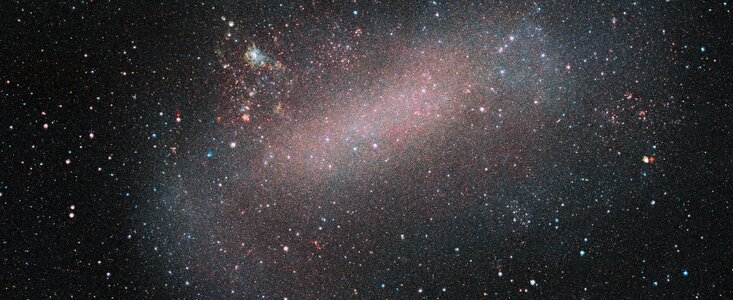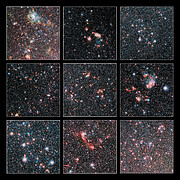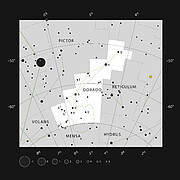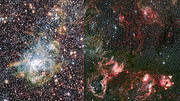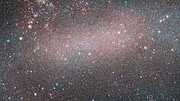Lehdistötiedote
VISTA:n ottama uusi kuva Suuresta Magellanin pilvestä on paljastettu
13. syyskuuta 2019
ESO:n VISTA-teleskoopin ottama hyvin näyttävä kuva Suuresta Magellanin pilvestä on paljastettu. Se on yksi meidän läheisistä galaksinaapureistamme. VISTA on kuvannut tätä galaksia ja sen sukulaista eli Pientä Magellanin pilveä, sekä niiden ympäristöä hämmästyttävällä tarkkuudella. Tämä taivaankartoitus antaa tähtitietelijöille näkymän lukuisiin tähtiin ja mahdollistaa tähtien kehityksen, galaksien dynamiikan ja muuttuvien tähtien tutkimuksen.
Suuri Magellanin pilvi on yksi meidän läheisistä galaksinaapureistamme vain noin 163000 valovuoden etäisyydellä Maasta. Sen sisargalaksin Pienen Magellanin pilven kanssa nämä ovat Linnunradan lähimpiä kääpiögalakseja. Suuri Magellanin pilvi on myös useiden tähtikasautumien paikka ja se on ideaalinen tähtitieteilijöiden laboratorio galakseja muuttavien prosessien tutkimiselle.
ESO:n VISTA-kaukoputki on havainnut näitä kahta galaksia viimeisen vuosikymmenen aikana. Tänään julkaistu kuva on yhden taivaankartoituksen tulos, mitä tähtitieteilijät ovat tällä teleskoopilla tehneet. VISTA:n Magellanin pilvien taivaankartoituksen (VISTA Magellanic Clouds (VMC) Survey) päätarkoituksena on ollut Suuren- ja Pienen Magellanin pilven tähtien synnyn historian kartoittaminen, sekä niiden kolmiulotteisten rakenteiden selvittäminen.
VISTA oli avainasemassa tämän kuvan ottamisessa, koska se havaitsee taivasta lähi-infrapunaisen valon aallonpituuden alueella. Tämän ansiosta se pystyy näkemään pölypilvien läpi, joita on osassa galaksia. Nämä pilvet estävät suurimman osan näkyvää valoa, mutta ovat läpinäkyviä pidemmilla aallonpituuksilla, mitä VISTA suunniteltiin havaitsemaan. Sen seurauksena galaksin keskustasta pystytään erottamaan paljon enemmän yksittäisiä tähtiä. Tähtitieteilijät analysoivat noin 10 miljoonaa yksittäistä tähteä ja määrittivät niiden iät käyttämällä viimeisimpiä tähtimalleja [1]. He huomasivat, että nuoret tähdet seuraavat useita galaksin spiraalihaaroja.
Magellanin pilvet ovat kiehtoneet eteläisen pallonpuoliskon ihmisiä vuosituhansien ajan, mutta ne olivat enimmäkseen tuntemattomia ennen löytöretkien aikaa. Nykyisin käyttämämme nimi palautuu löytöretkeilijä Ferdinand Magellaniin, ketä 500 vuotta sitten aloitti ensimmäisen purjehduksen maailman ympäri. Löytöretken aikana löydetyt uudet asiat paljastivat eurooppalaisille täysin uusia ennen tuntemattomia asioita. Löytöretkien henki ja löytämisen riemu on yhä näkyvissä tähtitieteilijöiden työssä ympäri maailman. Tähän joukkoon kuuluu VMC-tiimi, kenen havainnot johtivat tähän hämmästyttävään kuvaan Suuresta Magellanin pilvestä.
Lisähuomiot
[1] Tähtitieteilijät käyttävät tähtimalleja tähtien elämän ja kuoleman ennustamiseen, sekä antaa tutkimusvälineen niiden ikien, massojen ja lämpötilojen tutkimiselle.
Lisätietoa
Tässä kuvassa näkyvistä tähdistä on kerrottu tarkemmin artikkelissa “The VMC Survey - XXXIV. Morphology of Stellar Populations in the Magellanic Clouds”, mikä ilmestyy 'Monthly Notices of the Royal Astronomical Society' julkaisusarjassa.
ESO on Euroopan johtava hallitustenvälinen tähtitieteen organisaatio ja ylivoimaisesti maailman tieteellisesti tuotteliain tähtitieteellinen observatorio. ESO:lla on 16 jäsenmaata: Alankomaat, Belgia, Espanja, Iso-Britannia, Italia, Itävalta, Irlanti, Portugali, Puola, Ranska, Ruotsi, Saksa, Suomi, Sveitsi, Tanska ja Tšekin tasavalta, joiden lisäksi Chile toimii laitteistojen sijoitusmaana ja Australia strategisena kumppanina. ESO toteuttaa kunnianhimoista ohjelmaa, joka keskittyy tehokkaiden maanpäällisten havaintovälineiden suunnitteluun, rakentamiseen ja käyttöön. Välineiden avulla tähtitieteilijät voivat tehdä merkittäviä tieteellisiä löytöjä. ESO:lla on myös johtava asema tähtitieteen tutkimuksen kansainvälisen yhteistyön edistämisessä ja organisoinnissa. ESO:lla on Chilessä kolme ainutlaatuista huippuluokan observatoriota: La Silla, Paranal ja Chajnantor. ESO:lla on Paranalilla VLT-teleskooppi (Very Large Telescope) ja siihen liittyvä, maailmanlaajuisesti johtava VLTI-interferometri, sekä kaksi kartoitusteleskooppia. VISTA toimii infrapuna-alueella ja VST-teleskooppi näkyvän valon aallonpituuksilla. ESO on myös merkittävä kumppani kahdessa Chajnantorin laitteistossa, APEX-teleskoopissa ja ALMA-teleskoopissa, joka on maailman suurin tähtitieteellinen projekti. Lähellä Paranalia sijaitsevalla Cerro Armazonesilla ESO rakentaa 39-metrin kokoista ELT-teleskooppia (Extremely Large Telescope), josta tulee “maailman suurin tähtitaivasta havainnoiva silmä”.
Linkit
Yhteystiedot
Maria-Rosa Cioni
Leibniz-Institut für Astrophysik Potsdam (AIP)
Potsdam, Germany
Puh.: +49 331 7499 651
Sähköposti: mcioni@aip.de
Mariya Lyubenova
ESO Head of Media Relations
Garching bei München, Germany
Puh.: +49 89 3200 6188
Sähköposti: pio@eso.org
Pasi Nurmi (press contact Suomi)
ESO Science Outreach Network
and University of Turku
Turku, Finland
Puh.: +358 29 4504 358
Email: eson-finland@eso.org
Tiedotteesta
| Tiedote nr.: | eso1914fi |
| Nimi: | Large Magellanic Cloud |
| Tyyppi: | Local Universe : Galaxy : Type : Irregular |
| Facility: | Visible and Infrared Survey Telescope for Astronomy |
| Instruments: | VIRCAM |
| Science data: | 2019MNRAS.490.1076E |
